Winter is my favorite season for greens, because this season and on through to spring gives such a wide variety of wild horta. In the summer, vlita (amaranth) greens are readily available, but that's about it. It seems strange that they can grow so prolifically during the hot season - they need a lot of water to remain healthy plants. But in the winter, greens orchestrate a festival of the senses: there is a huge variety available if only you know where to look, and they each have their own appearance, taste, texture and smell. In this season, people all over Greece are getting down to their knees looking for wild greens.
Wild greens, cleaned and ready for use, have just started to appear in the fresh markets - at the hefty price of 6.50 a kilo for a mixture of wild greens. These greens are harvested from the countryside, cleared of grit and dirt (so they only need a good rinse), and sold as a mixture. Despite their weedy looks - they are hardly ever sowed as seeds, but simply grow wildly - most of them are highly aromatic. If you crush a few mixed leaves in your hand and smell them, they enervate you with an uplifting feeling, making you aware of the natural environment with their hands-on effect. Most of these greens are never sold separately, apart from the fennel, which is always sold in small bunches as a herb, in the same way as mint, dill and parsley. In Crete, wild greens are sold by the kilo, all mixed up together, which is also how they are used.
The bag I bought (I was able to fill it myself) contained: wild fennel, the Greek-type wild parsley and wild celery, wild leeks, sowthistle, swiss chard, wild mustard, hawksbeard, kafkalithres (known as hartwort, a species of Tordylium) and one or two more leaves which I couldn't identify; this shows how much progress I have made since last year, when I would buy them and never once wondered what their names were. A year on, I have even managed to track down articles in scientific journals concerning their nutrient values:
"The large variety of wildly grown edible greens differ every season ... and [are] eaten fresh in salads with plenty of virgin olive oil, or mixed and cooked with tomatoes, onions, meat or fish. They are also mixed and prepared as pies, thus increasing the daily vitamin and antioxidant intake. Edible wild plants are a common food source for the older generations of the population of Crete and continue today in families which maintain the traditional lifestyle. The Greek Orthodox religion plays an important role in the traditional diet, recommending approximately 180 or more days of fasting from meat, eggs and dairy products per year... The wildly grown Cretan greens are potentially a rich source of antioxidants in the [Cretan] diet... which plays an important role in the health of the elderly and rural population of Crete. ... The wild Cretan greens are rich sources of vitamin C, K, E and carotenoids, and capable of significantly contributing to the RDA needs of the population. In most cases, it was found that the wild greens had higher micronutrient content than those cultivated. ... further studies are required to evaluate the feasibilty of commercially growing some of the wild greens so that non-rural population can also reap the benefits of enriching their diet with traditional greens."
Out of curiosity I tracked down the sources of the wild greens used in the study, and found (to my chagrin) that they were NOT from Hania, but from every other province of Crete: Rethimno, Iraklio and Lasithi; this is simply because the research was based in Iraklio, and Hania was the province most further away to the study centre, the other provinces of Crete neighbouring Iraklio. But the wild greens being harvested and eaten by the local people are the same all over the island.
*** *** ***
The urban population need not worry about how to obtain these greens - it has expensive access to them via the fresh produce counters of the supermarkets and the daily street markets. But there is also a much cheaper source for the same greens, one that is not always feasible because of the restrictions of urban living.In actual fact, most of these greens are available in the gardens of most village dwellings. A patch of earth from our own garden revealed fennel, mustard, nettles, chickweed, making my purchase of wild greens sound rather expensive, given their availability at my doorstep. Here's the catch: think of the work required to search for these varieties among the clover flowers (which are also edible - the leaves are used in the Middle East in salad dressings when there is a shortage of lemons), clean them (they are collected at a time when the earth is still very muddy and wet), trim, wash and dry them. Now you know why freshly picked wild greens sometimes cost more than meat.
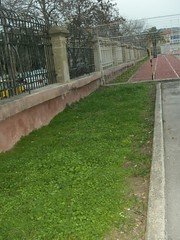
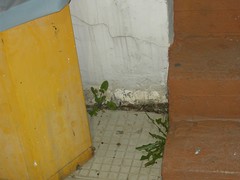
The stadium in the centre of Hania is full of wild greens. They grow around the tarmac used for track and field events, while tsohos (sowthistle) and radiki (dandelion) can be seen growing from a nutrient-packed sewer...
Just how much weed (in the legal sense) is edible all around us? What I found in my home garden alone made me realise just how much we take for granted. I also took a little tour of the peace-inspiring gardens of my workplace, and found a highly developed, sustainable - and highly edible - ecosystem. Susun Weed summarises the most common garden weeds found the world over in Western gardens if you want to find out what's edible in your own patch of earth. The most important consideration when using garden weeds as wild greens is to make sure you have identified them correctly as edible greens. Then you may also want to make sure animals haven't been treading them, because it will also mean that they've been doing other things there too. A forum discusses interesting ways to use dandelion weeds, one of the most popular garden greens growing in abundance in most people's lawns. And don't forget that these greens are probably the most organic carbon-footprint-less food you will eat in your life..
I'm not quite sure when I'll bring my own bag to collect the greens I found growing in abundance at MAICh; if my colleagues see me, they may think I've taken to the hills...
*** *** ***
These greens can be served as simple boiled greens dressed with the classic olive oil and lemon juice, accompanied by cheese and boiled eggs. I've also cooked them with rice, like a spanakorizo. In Crete, they are often turned into exotic traditional rustic dishes. They are so versatile that you could easily make a very different dish each day using the same greens.
To soften the pungent scents and tastes of the wild greens, I added some tamer greens (spinach) to the wild mixture:

For those who like their horta raw, try this mixture (with salt, pepper and olive oil added - soft curd cheese optional) on a piece of toasted bread of any kind.
This mixture was used to create the following dishes:
- calamari with wild greens and green olives (kapama) in tomato sauce, served with rice:
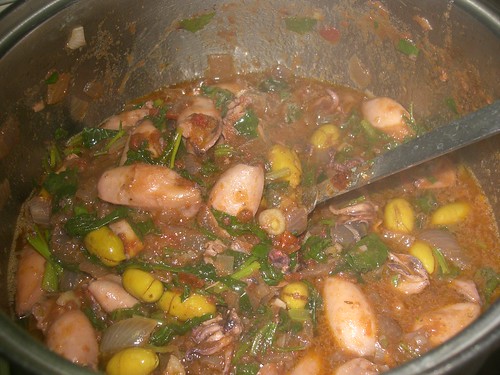
The greens can be used chopped or whole - we prefer them cut up into the sauce. This method of cooking greens (in a tomato sauce) is generally known as 'tsigariasto'; adding frozen calamari and olives turns the dish into 'kapama'.
- and marathopites, small vegan pasties, a local specialty in Hania, my all-time favorite pie:
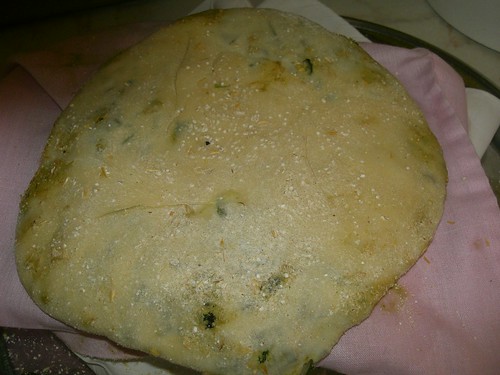
This μαραθόπιτα (marathopita - fennel pie) has a seamless look to it. The greens mixture is encased in pastry. This pie is traditionally cooked on a very hot oiled skillet called a 'satsi'. I added more fennel to the mixture for more taste.
This is my entry for Weekend Herb Blogging, hosted this week by Marija from Palachinka.
This one's for Cheryl, who could make a mint by selling wild greens from her own garden.
©All Rights Reserved/Organically cooked. No part of this blog may be reproduced and/or copied by any means without prior consent from Maria Verivaki.

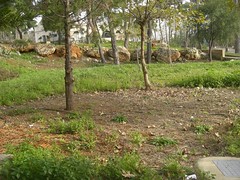

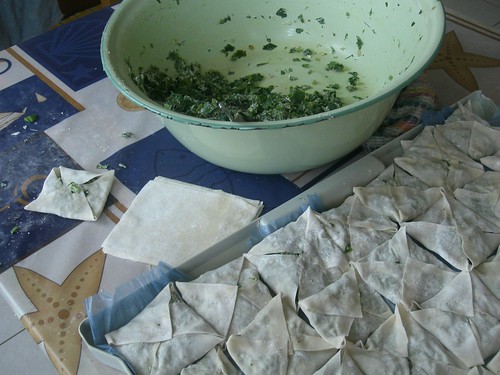
this is an awesome list with photos and all, thank you for showing us which weeds we can eat. i'll be on the look out!! thanks!!
ReplyDeleteLovely post Maria! My garden before we moved to this, our new home, had many dandelions throughout spring, summer and fall. I have yet to experience the full potential of our garden here. But you have definitely inspired me to work on it with all your wonderfully orgnaic posts.
ReplyDeleteSome of the greens you mentioned like sowthistle and hawksbeard I've never heard of, much less tasted. But your pictures and recipes (especially the calamari) are so tempting! Our backyard is covered in snow right now but I wonder what I might find out there. Too bad that neatly trimmed and manicured grass is highly desired in most of suburban US; the greens that you show probably would be/are pulled up and discarded as weeds.
ReplyDeleteI wish churches in America made useful & healthful dietary recommendations like the 180 days of fasting from meat, eggs and dairy a year. Smart.
ReplyDeleteI just visited you other blog and really liked your post about foraging with your mother.
Those wild greens with calamari & green olives, if I could only have that for dinner now, yummy!
Maria, I would pay $$$ for a Cretan salad mix at the green grocer. Look at the versatility here (not to mention healthy).
ReplyDeleteI love the thought of eating weeds - you're very enterprising!
ReplyDeleteYou are so right Maria! I could make a killing. MIL loves collecting from me. But, I'm warming up to horta...I actually broke down and had some recently. I think that I've even said that I probably wouldn't try it...well...now my foot is in my mouth. I've said I wouldn't fry fish indoors-did that two days ago.
ReplyDeleteBack to horta/wild greens-there's hope for me yet! :)
Those kalitsounia look luscious. I tried foraging for nettles this past spring and they turned out to be harvested too late (they have bristles after a certain date in their development) so I was foiled in my attempts, but I will try earlier this spring.
ReplyDeleteI would love to try one of those pies. :-)
ReplyDeleteMaria, You have so much knowledge about greens. I really liked the look of that calamari and greens that you put together, and that pie would put me over the moon! I really like greens and rice together (I had broccoli and rice for lunch today ... not really a "green", but you know what I mean.) I saw some Greek style celery (like the one you posted about a couple posts ago) last week and pulled my kids over to show them the difference. I was so excited to see it! Actually, I think I'd enjoy the greens in all the ways you've shown, YUM!
ReplyDeleteFennel seeds are regular at our place.I'm going to try making this incredibly simple pie with fennel greens,looks wholesome.
ReplyDeleteThis is an unbelievable combination! It fits perfect in almost any savory dish!
ReplyDeleteWonderful pictures Maria. I can't wait for spring!
ReplyDelete